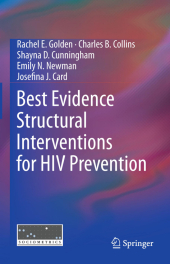 Neuerscheinungen 2015Stand: 2020-02-01 |
Schnellsuche
ISBN/Stichwort/Autor
|
Herderstraße 10
10625 Berlin
Tel.: 030 315 714 16
Fax 030 315 714 14
info@buchspektrum.de |

Charles B. Collins, Shayna D Cunningham, Rachel E Golden
(Beteiligte)
Best Evidence Structural Interventions for HIV Prevention
2013. 2015. viii, 352 S. 3 Tabellen. 235 mm
Verlag/Jahr: SPRINGER, BERLIN; SPRINGER NEW YORK; SPRINGER 2015
ISBN: 1-489-99746-6 (1489997466)
Neue ISBN: 978-1-489-99746-3 (9781489997463)
Preis und Lieferzeit: Bitte klicken
This book reports on successful HIV prevention initiatives from across the globe, representing countries in Europe, Asia, Africa, and the Americas at diverse stages of the epidemic. It examines interventions at both the individual and community levels.
Providing detailed information on structural HIV prevention interventions, this book is intended for health care practitioners and researchers to plan, implement, and evaluate such interventions in their own communities. As defined by the CDC, structural interventions focus on the physical, social, cultural, political, economic, legal, and/or policy aspects of the environment. Designed to reach a large number of individuals, structural interventions usually occur across entire communities, cities, or countries. As a result, the resources required to initiate structural interventions can far exceed those required for smaller-scale behavioral programs. However, changes from structural interventions have the potential to last over time, even after the programs have ended, resulting in effective use of public and private prevention resources. Because the reach of structural interventions is typically larger than that of individual- or group-focused interventions (for example, the 100% Condom Use Program, which was implemented countrywide in Thailand), their influence may be equally-if not more-significant.This book is a resource for health practitioners, educators, and researchers who seek HIV/AIDS structural prevention programs that have been shown to be effective in their regions or for their target populations (e.g. injection drug users, commercial sex workers, or the general public). With extensive case studies, the book classifies interventions according to the desired outcomes (specific behavior or policy changes) so that the reader may focus on examples of programs with similar goals and target populations to their own. Addresses the quintessential public health ethical dilemma regarding which types of environmental changes should be mandatory via legislation and which should be voluntary, promoted via programmatic, practice, and policy change.
From the reviews:
"This volume, which details the evidence for structural interventions, is a resource to service providers, planners, policy makers, and funders. ... of interest to academics, nongovernmental organization workers, policy makers, economists, and others interested in addressing the HIV pandemic at a population level. ... As a reference for practitioners in HIV prevention, this volume should be a first port of call. It is an important contribution to the field." (Ashraf Kagee, PsycCRITIQUES, Vol. 59 (11), March, 2014)


